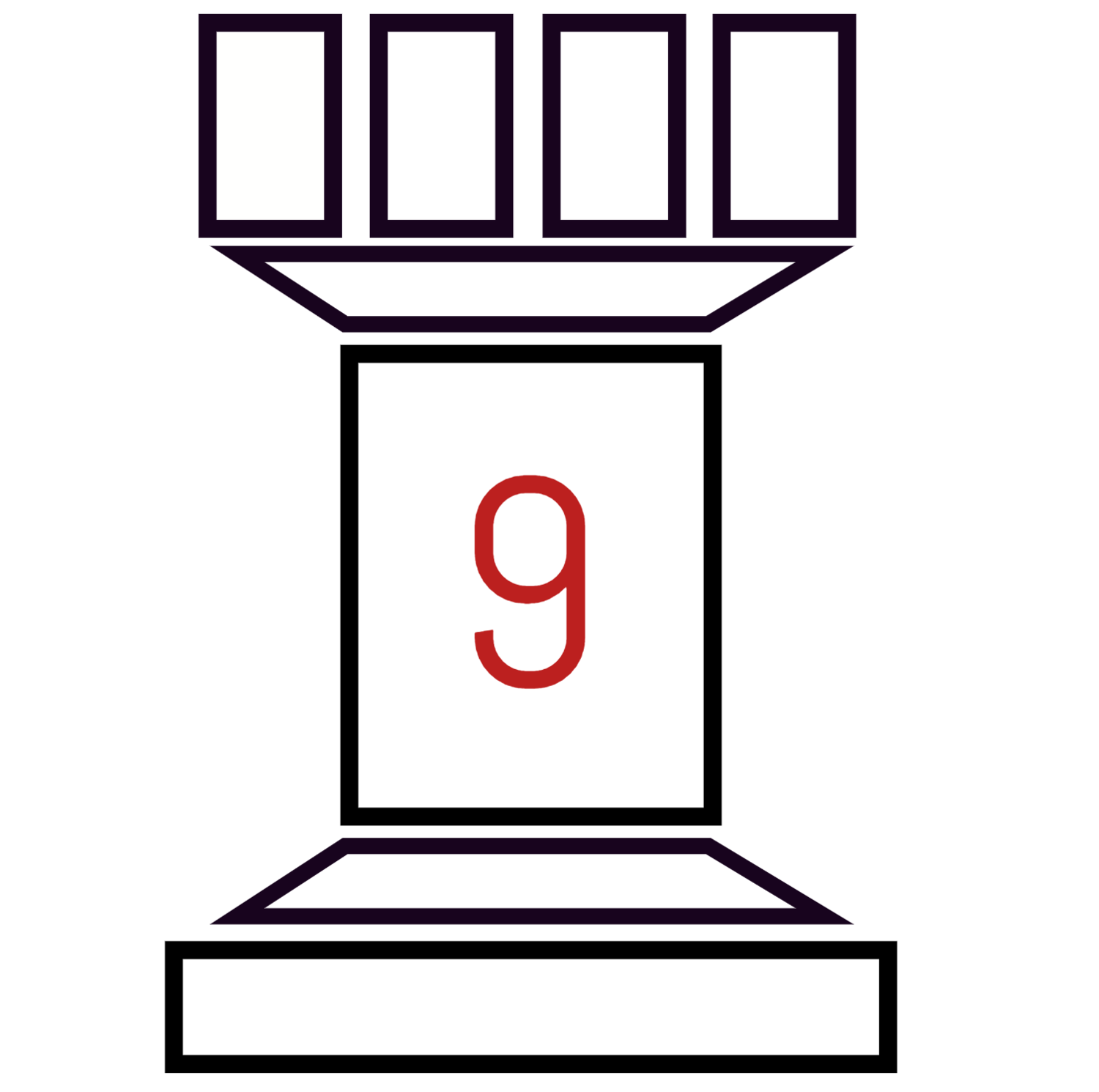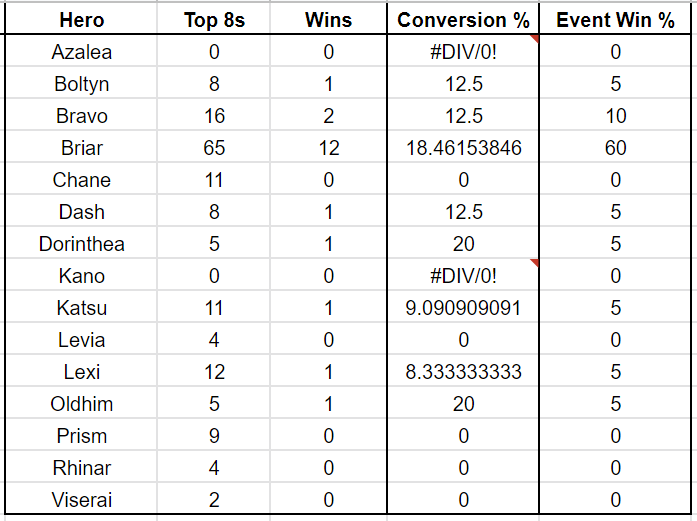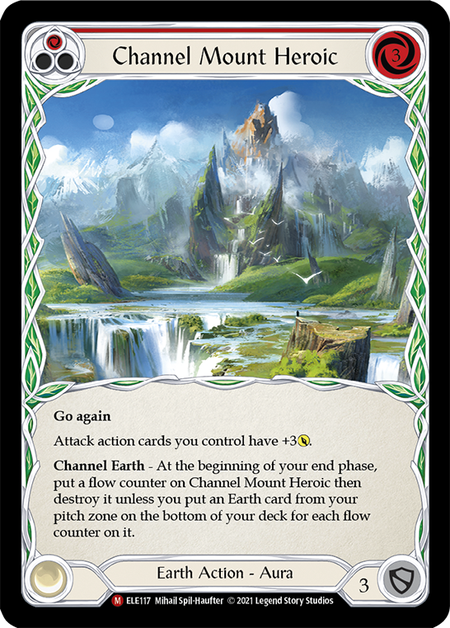Flesh and Blood Meta Review Part One: Nationals
Hello all! I’ve been following event results from Flesh and Blood recently in the tracking spreadsheet and think there are some interesting takeaways to be had. Before we get to the meat of the article I want to quickly plug the Skirmish event result form. If you have results from a Skirmish event please fill out this form and I will get them into the spreadsheet! (The form doesn’t populate the sheet automatically, but I plan to check in frequently during the season).
With that taken care of, let’s get to the data!
Nationals
I believe all Nationals events have now been resolved (aside from those which have been cancelled or postponed thanks to COVID). Going into the first Nationals, the general view seemed to be that with Chane mostly out of the picture thanks to the Seeds of Agony and Duskblade bans, Prism and Bravo would end up being some of the decks to watch out for. However, this prediction was quickly proven false...
Not a typo as far as I know… Briar really won twelve out of twenty Nationals events!
A new hero burst onto the scene — Briar. This Elemental Runeblade had seemed inferior to Chane at first glance, but with the Chane nerfs in place and some time to build things looked very different. Perhaps one of the first notable results was when Briar took third and fourth place at the Pro Quest in Cincinnati, but the decks that did so would go on to have a much greater impact in future events! In particular, Chris Higashi played with a build focused on powerful zero-cost cards, running many cheap attacks with go again as well as powerful non-attack actions like Plunder Run and very few blues. 0-cost (or “Cheerios”) Briar went on to win UK Nationals and then take many other events by storm. This deck has been credited to Tariq Patel, who piloted his own version to a US Nationals win!
In fact, Briar’s extremely strong results this season demonstrate a potential flaw in the conversion percentage metric — since Briar is such a huge percentage of the top eight at some of these events, her conversion percentage is probably lower than it “should be” since only one of the many Briars who make the cut can win any given event — in other words, Briar players knocking one another out in the top cut makes Briar’s conversion percentage unusually low!
Briar’s performance in Nationals was so successful that my current estimates indicate she has overtaken Chane in terms of CC Living Legend points! However, I think that Briar’s performance does not necessarily reflect a dominant deck. Unlike the Road to Nationals season — which lasted more than a month — Nationals season was mostly just two weeks (with UK Nationals a week before and Taiwan Nationals a week after). In Road to Nationals season, we saw fatigue decks winning out over Chane in several events in the first two weeks, but as the season went on Chane players adapted and soon fatigue was quite a favored matchup for a skilled Chane player! The Nationals season didn’t offer that same time to adapt — when zero-cost Briar won UK Nationals and became an obvious threat, people had less than a week to prepare for US Nationals, and later events didn’t have much longer!
As a result, we’re seeing a bit of a “snapshot meta” here in my view —Briar’s results aren’t necessarily the result of her being incredibly overpowered, but rather of people being unprepared to face her. Even people who take the game very seriously report not having really had enough time to test and hone their builds against the Briar threat, so with a new and powerful archetype suddenly taking the field it ended up getting big results — further, some players who had been planning to run something else likely just “threw up their hands” and swapped onto the new deck.
A Tale of Two Briars
Another interesting thing about these results is that Briar actually did well with two different builds! The first, the famous 0-cost or “Cheerios” Briar developed by Tariq Patel, has gotten most of the attention — but there’s another powerful tournament-winning Briar deck out there, which I call “Channel Mt. Heroic” Briar. Like 0-cost Briar, the Channel Mt. Heroic builds feature lots of strong cheap attacks; unlike 0-cost Briar, the deck runs a significant number of blues in order to support its centerpiece card — Channel Mount Heroic.
Flesh and Blood TCG is © Legend Story Studios.
Interestingly, the Channel Mt. Heroic type build first became apparent at the same Pro Quest where Chris Higashi played 0-cost Briar — Brendan Patrick ended up in the 3rd/4th place position with an Earth-focused build. However, Brendan said after the event that it had been a meme deck and attention seemed to shift away. In Europe, though, an interesting deck came out that was kind of a mix between Brendan and Chris’s build, dropping several of the more expensive cards to run more 0-cost go again attacks but keeping Channel Mt. Heroic. This deck ended up winning Austrian, German, and Polish Nationals, as well as taking top eights at several other events! Here’s an example — the deck Lukasz Cichecki used to win in Poland (the largest European Nationals event).
These Channel Mt. Heroic builds allow for a similar tactic to zero-cost Briar, but if they can get a copy of Channel Mt. Heroic on the board, it can really magnify their attacks a lot. Further, their significantly increased blue count means that it is easier to deal with Ice opponents and their Frostbite tokens, which have emerged as a potential counter to the 0-cost builds. On the other hand, the deck does run some not so great cards to get those blue Earth choices it uses to enable Mt. Heroic, which can potentially lead to weak or inconsistent turns.
Personally I actually think the Channel Mt. Heroic based builds are stronger than the pure zero-cost compositions, but time will tell whether either deck remains strong as players adapt and try to counter.
The Future
At present, the competitive focus has shifted towards Blitz play thanks to the new Skirmish season (more on that in an upcoming post!), and with Everfest on the horizon (early February 2022) it’s unlikely we’ll see a huge amount of evolution and growth in the Classic Constructed meta thanks to a lack of major CCevents for most players. That said, there are two big events left to be played. With Australian and New Zealand Nationals having been postponed until late January of 2022, it will be interesting to see what the meta looks like at what might well be two of the the most competitive Nationals, especially given that players will have had more time to adjust and counter. I’ll be surprised if zero-cost Briar ends up taking those events, but we’ll have to wait and see.
One topic that has come up in the community is potential bans, with Rosetta Thorn and Plunder Run mentioned as potential targets. Personally I think bans are premature at this phase. If Briar proves totally dominant at NZ and Australian Nationals even after players have had a lot of prep time, that might be something else, but as it stands I think that the data on Briar exists in too much of a weird meta bubble thanks to the time constraints to necessitate major changes.
I’ll have a second article out soon (edit: out now!) with respect to Skirmish results — please submit results via the form to help better track those — but that’s going to do it for now! Best of luck for those competing in the Skirmish season and testing for Australian and New Zealand Nationals!


